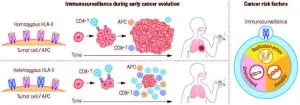Compound vital for all life likely played a role in life’s origin
A chemical compound essential to all living things has been synthesised in a lab in conditions that could have occurred on early Earth, suggesting it played a role at the outset of life, finds a new study led by UCL researchers.
The compound, pantetheine, is the active fragment of Coenzyme A. It is important for metabolism - the chemical processes that maintain life. Earlier studies failed to synthesise pantetheine effectively, leading to suggestions that it was absent at life’s origin.
In the new study, published in the journal Science, the research team created the compound in water at room temperature using molecules formed from hydrogen cyanide, which was likely abundant on early Earth.
Once formed, the researchers said, it is simple to envisage how pantetheine might have aided chemical reactions that led from simple forerunners of protein and RNA molecules to the first living organisms – a moment that is thought to have occurred 4 billion years ago.
The study challenges the view among some researchers in the field that water is too destructive for life to originate in it and that life more likely originated in pools that periodically dried out.
Driving the reactions that produced pantetheine were energy-rich molecules called aminonitriles, which are closely chemically related to amino acids, the building blocks of proteins and of life.
Members of the same team, led by Professor Matthew Powner (UCL Chemistry), have already used similar chemistry powered by aminonitriles to demonstrate how other key biological ingredients could be created at the origin of life, including peptides (protein-creating chains of amino acids) and nucleotides (the building blocks of RNA and DNA).
Professor Powner, senior author of the paper, said: “This new study is further evidence that the basic structures of biology, the primary molecules that biology is built from, are predisposed to form through nitrile chemistry.
“The ease with which different classes of biological molecules can be made using nitriles has convinced me that, rather than life being preceded by one molecule such as RNA, and there being an ‘RNA world’ before life began, the basic molecules of biology emerged alongside each other – a network of RNAs, proteins, enzymes and cofactors leading to the first living organisms.
“Our future work will look at how these molecules came together, how pantetheine chemistry talks to RNA, peptide and lipid chemistry for instance, to deliver chemistry that the individual classes of molecule could not deliver in isolation.”
A notable earlier attempt to synthesise pantetheine was made in 1995 by the late American chemist Stanley Miller, who had started the field of origin of life experiments three decades earlier, creating amino acids from four simple chemicals in glass tubes.
However, in the later 1995 experiment, the yields of pantetheine were very low and required extremely high concentrations of chemicals that had been dried out and sealed in an airtight tube before they were heated to 100 degrees Centigrade.
Dr Jasper Fairchild (UCL Chemistry), a lead author of the study, who conducted the work as part of his PhD, said: “The major difference between Miller’s study and ours is whereas Miller tried to use acid chemistry, we used nitriles. It’s the nitriles that bring the energy and the selectivity. Our reactions just run in water and produce high yields of pantetheine with relatively low concentrations of chemicals needed.”
Professor Powner added: “It had been assumed you should make these molecules from acids, because using acids appears to be biological, and that is what we are taught at school and at university. We are taught peptides are made from amino acids.
“Our work suggests this conventional view has ignored an essential ingredient, the energy required to forge new bonds. The reactions look a little different with nitriles but the end products – the basic units of biology – are indistinguishable whether formed through acid or nitrile chemistry.”
While the paper focuses solely on the chemistry, the research team said that the reactions they demonstrated could plausibly have taken place in pools or lakes of water on the early Earth (but not likely in the oceans as the concentrations of the chemicals would likely be too diluted).
The new study was supported by the Engineering and Physical Sciences Research Council, the Simons Foundation and the Volkswagen Foundation. As a result of his work on the origins of life, Professor Powner was named a finalist in the 2021 Blavatnik Awards for Young Scientists. The awards are for scientists aged 42 or younger whose research “is already transforming technology and our understanding of the world”.
Compound vital for all life likely played a role in life’s origin
A chemical compound essential to all living things has been synthesised in a lab in conditions that could have occurred on early Earth, suggesting it played a role at the outset of life, finds a new study led by UCL researchers.
The compound, pantetheine, is the active fragment of Coenzyme A. It is important for metabolism - the chemical processes that maintain life. Earlier studies failed to synthesise pantetheine effectively, leading to suggestions that it was absent at life’s origin.
In the new study, published in the journal Science, the research team created the compound in water at room temperature using molecules formed from hydrogen cyanide, which was likely abundant on early Earth.
Once formed, the researchers said, it is simple to envisage how pantetheine might have aided chemical reactions that led from simple forerunners of protein and RNA molecules to the first living organisms – a moment that is thought to have occurred 4 billion years ago.
The study challenges the view among some researchers in the field that water is too destructive for life to originate in it and that life more likely originated in pools that periodically dried out.
Driving the reactions that produced pantetheine were energy-rich molecules called aminonitriles, which are closely chemically related to amino acids, the building blocks of proteins and of life.
Members of the same team, led by Professor Matthew Powner (UCL Chemistry), have already used similar chemistry powered by aminonitriles to demonstrate how other key biological ingredients could be created at the origin of life, including peptides (protein-creating chains of amino acids) and nucleotides (the building blocks of RNA and DNA).
Professor Powner, senior author of the paper, said: “This new study is further evidence that the basic structures of biology, the primary molecules that biology is built from, are predisposed to form through nitrile chemistry.
“The ease with which different classes of biological molecules can be made using nitriles has convinced me that, rather than life being preceded by one molecule such as RNA, and there being an ‘RNA world’ before life began, the basic molecules of biology emerged alongside each other – a network of RNAs, proteins, enzymes and cofactors leading to the first living organisms.
“Our future work will look at how these molecules came together, how pantetheine chemistry talks to RNA, peptide and lipid chemistry for instance, to deliver chemistry that the individual classes of molecule could not deliver in isolation.”
A notable earlier attempt to synthesise pantetheine was made in 1995 by the late American chemist Stanley Miller, who had started the field of origin of life experiments three decades earlier, creating amino acids from four simple chemicals in glass tubes.
However, in the later 1995 experiment, the yields of pantetheine were very low and required extremely high concentrations of chemicals that had been dried out and sealed in an airtight tube before they were heated to 100 degrees Centigrade.
Dr Jasper Fairchild (UCL Chemistry), a lead author of the study, who conducted the work as part of his PhD, said: “The major difference between Miller’s study and ours is whereas Miller tried to use acid chemistry, we used nitriles. It’s the nitriles that bring the energy and the selectivity. Our reactions just run in water and produce high yields of pantetheine with relatively low concentrations of chemicals needed.”
Professor Powner added: “It had been assumed you should make these molecules from acids, because using acids appears to be biological, and that is what we are taught at school and at university. We are taught peptides are made from amino acids.
“Our work suggests this conventional view has ignored an essential ingredient, the energy required to forge new bonds. The reactions look a little different with nitriles but the end products – the basic units of biology – are indistinguishable whether formed through acid or nitrile chemistry.”
While the paper focuses solely on the chemistry, the research team said that the reactions they demonstrated could plausibly have taken place in pools or lakes of water on the early Earth (but not likely in the oceans as the concentrations of the chemicals would likely be too diluted).
The new study was supported by the Engineering and Physical Sciences Research Council, the Simons Foundation and the Volkswagen Foundation. As a result of his work on the origins of life, Professor Powner was named a finalist in the 2021 Blavatnik Awards for Young Scientists. The awards are for scientists aged 42 or younger whose research “is already transforming technology and our understanding of the world”.
END


